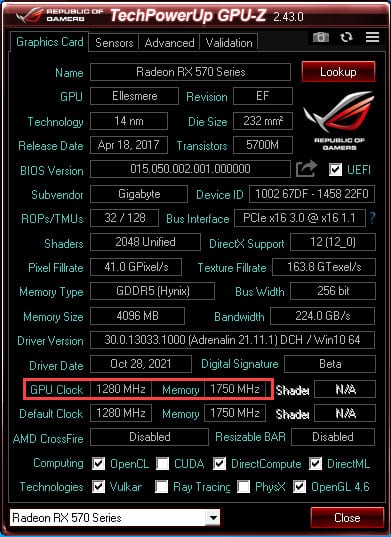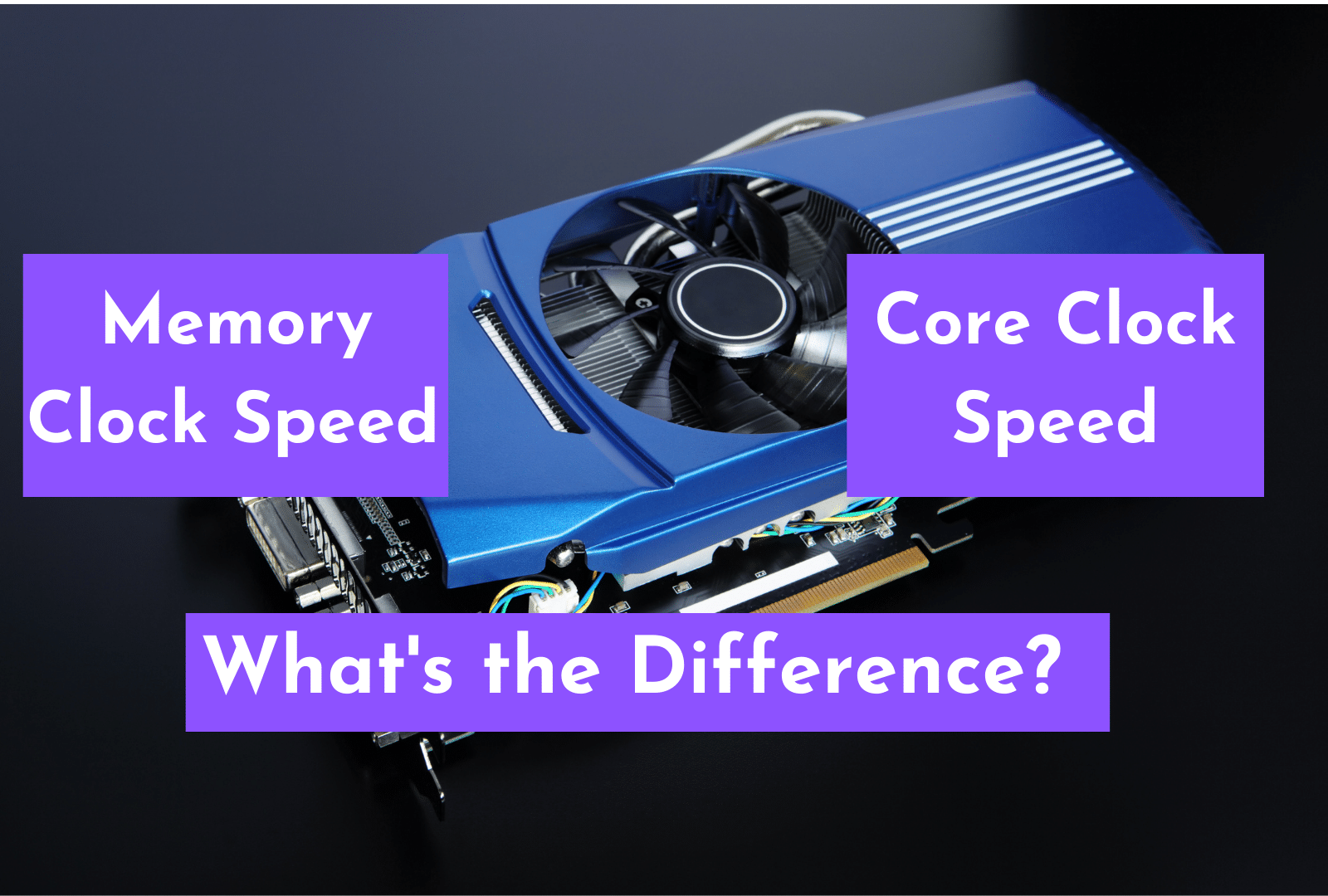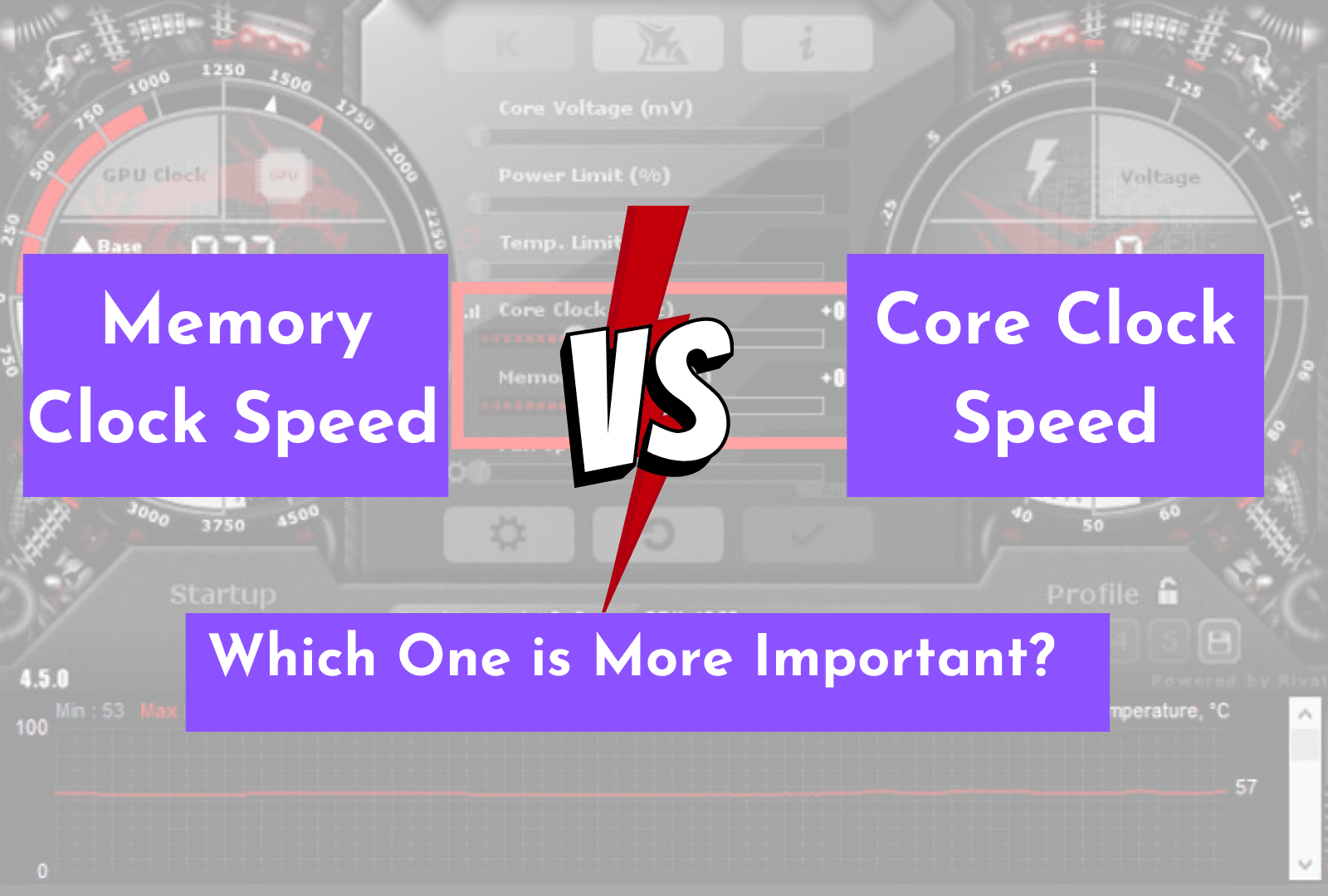When it comes to core clock vs memory clock importance, understand that the memory clock is just as important as the core GPU clock. For gaming, the GPU core clock speed is generally more important. However, for tasks that involve a lot of memory usage, such as video editing or rendering, the GPU memory clock speed is more important. So both Memory Clock Speed and GPU Core Clock Speed are important.
Core clock determines the speed at which the GPU processes instructions, while memory clock measures the speed at which the GPU can access data stored in its memory.
When it comes to gaming and other graphics-intensive activities, understanding the difference between GPU memory clock speed and GPU core clock speed is essential.
Both of these components have an impact on the performance of a computer’s graphics card. So it’s important to know which one is more important.
By understanding how the core clock and memory clock work together, you can make sure that your graphics card is running at its best.
In this blog post, we’ll explain the differences between core clock and memory clock and discuss which one is more important for optimal performance.
What is a GPU Core Clock Speed?

The clock speed indicates the number of oscillations per second performed by silicon. Suppose the GPU’s core clock is 1000MHz, meaning it cycles (the silicon crystal oscillates) 1,000,000 times per second.
Higher core clock speeds will usually result in increased performance in games and other graphics-intensive applications.
Overclocking is the process of increasing the clock speed above what is specified by the manufacturer. This can increase performance at the cost of additional power consumption and heat output.
It also affects how quickly the VRAM (video RAM) on your graphics card can access information.
A higher memory clock speed means more effective memory bandwidth, which can lead to improved fps (frames per second) when gaming or benchmarking.
GPU Core Clock Speed is an important spec to consider when choosing a graphics card.
While higher clock speeds usually provide a better performance, it’s important to consider other specs as well, such as a number of cores, architecture type, and amount of VRAM.
Many AMD and NVIDIA graphics cards have their own way of measuring and reporting clock speeds. So make sure to compare the same spec when looking at different cards.
Ultimately, understanding the difference between Memory Clock Speed and GPU Core Clock Speed will help you find the right graphics card for your needs.
Related Reading
- How To Overclock Graphic Cards?
- Why Your GPU Usage Drops To Zero During Gameplay?
- What is GDDR Memory?
What Is A GPU Memory Clock Speed?
A GPU’s memory clock measures the speed of its VRAM.
A GPU memory clock speed, also known as a graphics card memory clock, is the rate at which data is transferred between the random access memory (RAM) and the GPU core.
The memory clock speed is measured in Megahertz (MHz).
The GPU memory clock speed impacts the effective memory clock, which determines how much data can be read from or written to the RAM.
It influences things like texture loading times and graphics quality, as well as memory bandwidth, which affects game performance.
What’s The Difference Between Memory Clock and Core Clock on a GPU?

The difference between memory and core clock speed is that GPU memory clock speed refers to the speed at which the graphics processing unit (GPU) accesses and uses memory, while the GPU core clock speed refers to the speed at which the GPU’s processor operates.
In tasks such as video editing, where memory is a significant factor, the core clock speed is more important whereas in tasks requiring processing power, the memory clock speed is more important.
When shopping for a new graphics card or CPU, it’s important to understand the difference between GPU Memory Clock Speed and GPU Core Clock Speed.
Both are important in determining the performance of your GPU, but what’s the difference in both?
Here’s the difference between memory and core clock speed in comparison form.
|
GPU Memory Clock Speed |
GPU Core Clock Speed |
|
GPU Memory Clock Speed refers to the frequency of the memory on your graphics card, measured in MHz. The higher the memory clock speed, the faster data can be retrieved from the memory and sent to the GPU core, meaning higher frame rates and better performance. However, a higher memory clock speed can also cause increased power consumption. |
On the other hand, GPU Core Clock Speed is the frequency of the GPU core itself, measured in GHz. This determines how fast instructions can be processed by the GPU core, meaning more efficient usage of the graphics card. It also helps control the temperature of your graphics card, as a higher core clock speed generates more heat. |
Memory Clock Vs Core Clock – Which One Is More Important?
For GPU performance, both memory clocks and core clocks are crucial, but the importance of each depends on the specific use case. A memory clock is more important when performing tasks that require a lot of memory, such as editing video or rendering. For tasks that require processing power, such as gaming, the core clock is more important. For optimal performance, the best GPU will balance memory and core clock speeds.
It really depends on what kind of game you are playing.
If you are playing a fast-paced shooter, then you should focus on a higher core clock speed since it will help give you smoother frame rates and better overall performance.
However, if you are playing something more visually demanding, then you should focus on a higher memory clock speed. This will give you better visuals and a more immersive gaming experience.
It’s also important to consider Effective Memory Clock when shopping for a graphics card. This is an estimate of the real-world performance of your GPU based on its memory bandwidth.
So if you’re looking for the best possible performance for your graphics card, make sure to factor in Effective Memory Clock in your decision-making process.
In conclusion, both GPU Memory Clock Speed and GPU Core Clock Speed are essential when it comes to getting the best performance out of your graphics card. While one may be more important than the other depending on the type of game you are playing, both should be taken into consideration when choosing a GPU.
Related Reading:
- What Are NVIDIA CUDA Cores And What Do They Mean For Gaming?
- Can You Use A FreeSync Monitor With Nvidia Graphics Cards?
Which One Is More Important For Gaming? GPU Clock Speed Or Effective Memory Clock?

When it comes to gaming, both the GPU memory clock speed and the GPU core clock speed play an important role.
The graphics card has a certain amount of onboard memory which is used to store information and process images and textures. It is where the clock speed comes in. The clock speed or frequency of the GPU determines how quickly the memory can be accessed and processed.
When looking at GPU clock speeds, it’s important to distinguish between memory clock speed and core clock speed. Memory clock speed refers to the rate at which data can be moved from the memory to the GPU core, while core clock speed is the rate at which instructions can be executed by the GPU core.
Generally, the higher the memory clock speed, the faster the effective memory clock, resulting in higher memory bandwidth.
On the other hand, the GPU core clock speed directly affects how quickly your game will run, since it’s responsible for how fast your GPU processes instructions and graphics.
Increasing your core clock speed will result in smoother gaming performance, although there is a risk of overclocking your graphics card and causing hardware failure.
Overall, both the memory clock and core clock speeds are important for gaming performance. But you should always prioritize increasing your GPU core clock speed over increasing your memory clock speed for the best gaming experience.
Related Reading:
- What Should I Upgrade First GPU Or CPU?
- How Does An External Graphic Unit Work? And Why Are They Important?
How do GPU Core Clocks Impact Performance?
The GPU core clock speed is an important factor when considering the performance of a graphics card. It measures how quickly the processor within the GPU can perform calculations, with higher clocks speeds resulting in faster rendering and more efficient processing.
A high effective memory clock and a fast gpu core clock speed allows for better gaming performance, as data is able to be accessed faster and more efficiently.
The higher the core clock speed, the higher the potential of the graphics card.
On the other hand, memory bandwidth is also affected by memory clock speed; if the clock speed is low, then data will be transferred slower, resulting in poorer performance overall.
To conclude, both GPU memory clock speed and core clock speed are important factors when considering gaming performance.
If you are looking to improve your gaming experience, consider investing in a graphics card with a higher GPU core clock speed.
Conclusion
In conclusion, the difference between memory clock speed and GPU core clock speed is critical to consider when selecting a graphics card.
Memory clock speed is important for controlling the effective memory clock of the GPU, while GPU core clock speed determines how quickly the GPU processes data.
Both clock speeds are related to memory bandwidth, which affects how much data can be moved through the GPU.
Ultimately, the choice between memory clock speed and GPU core clock speed depends on the user’s needs and goals for their graphics card.
